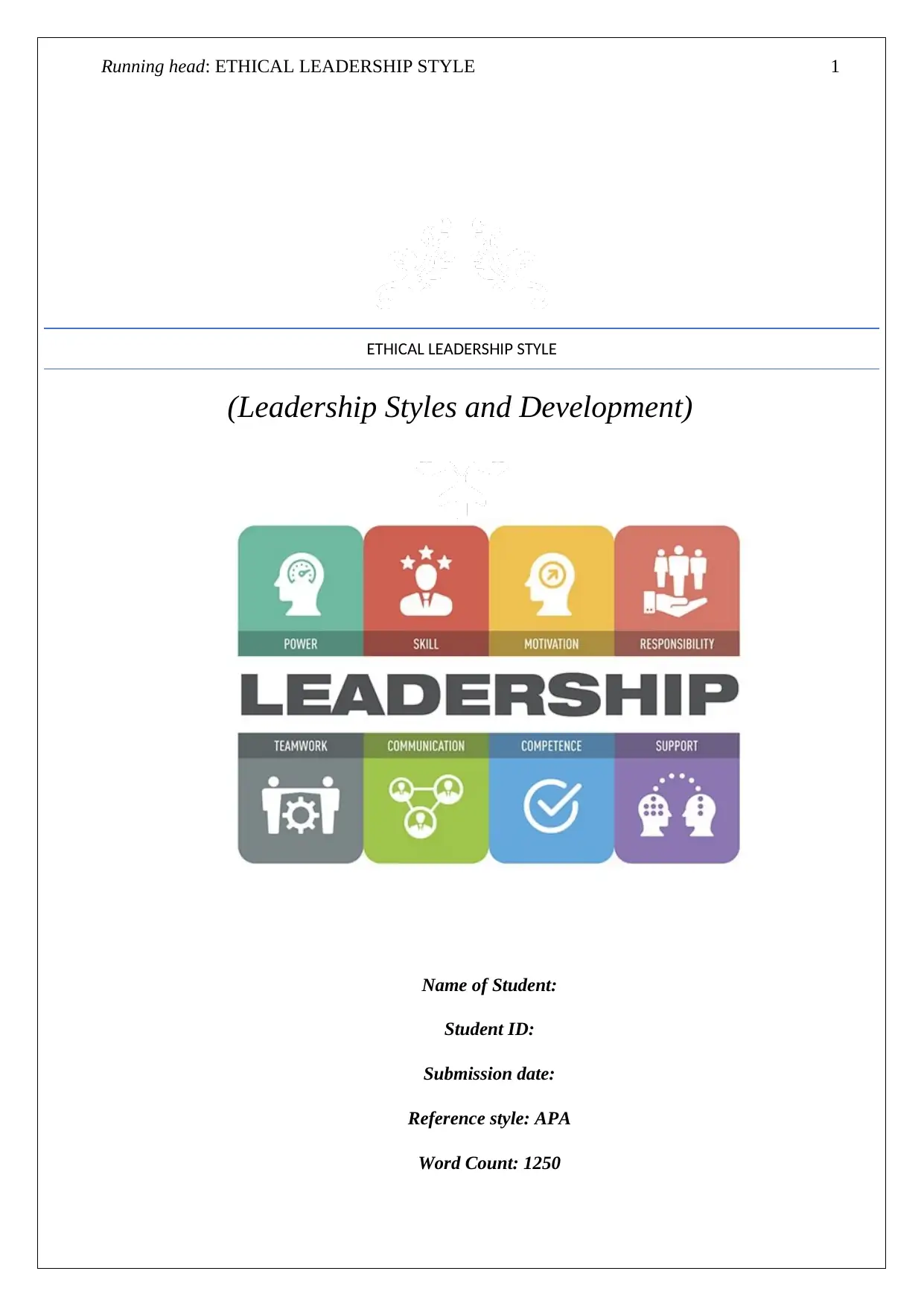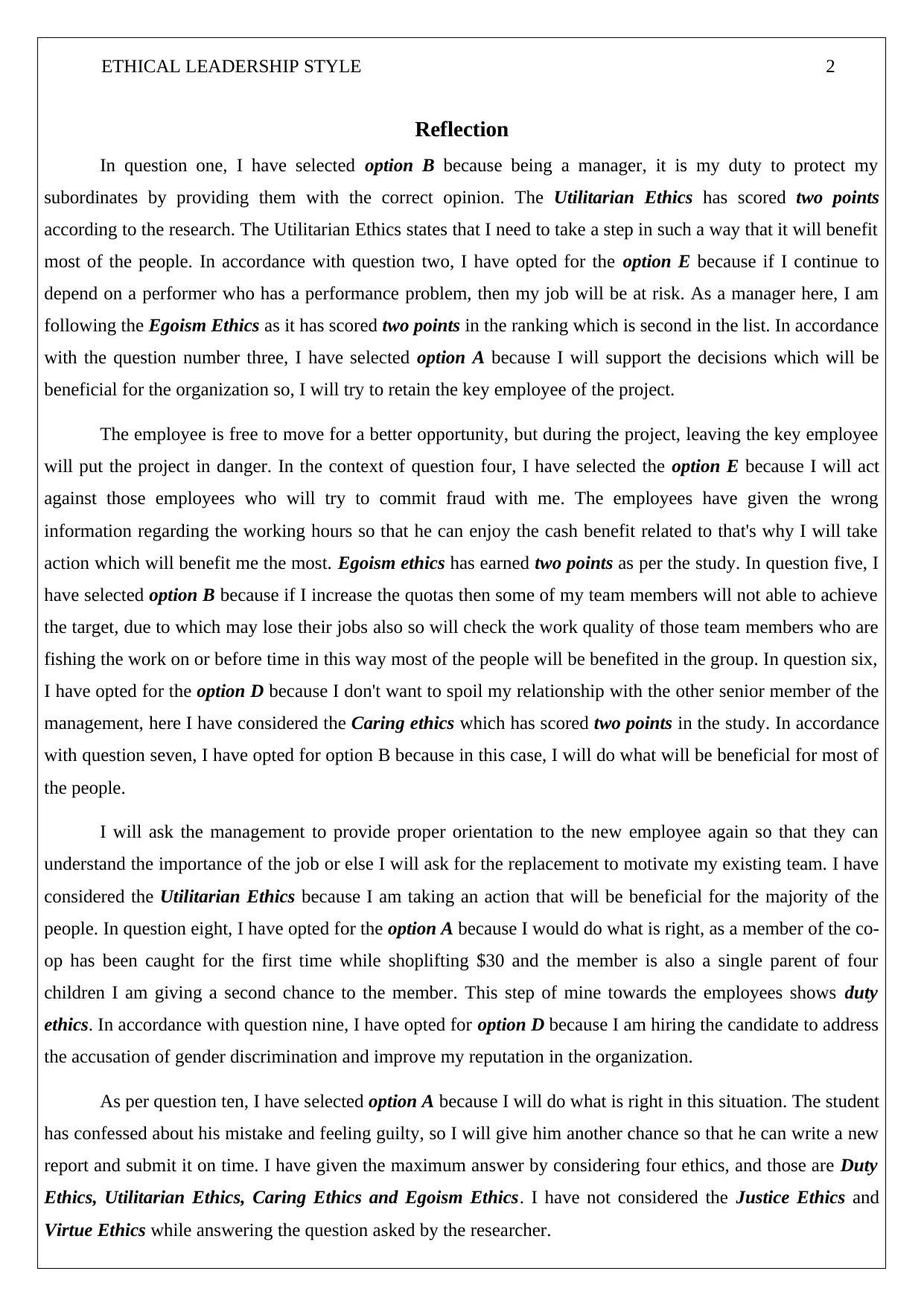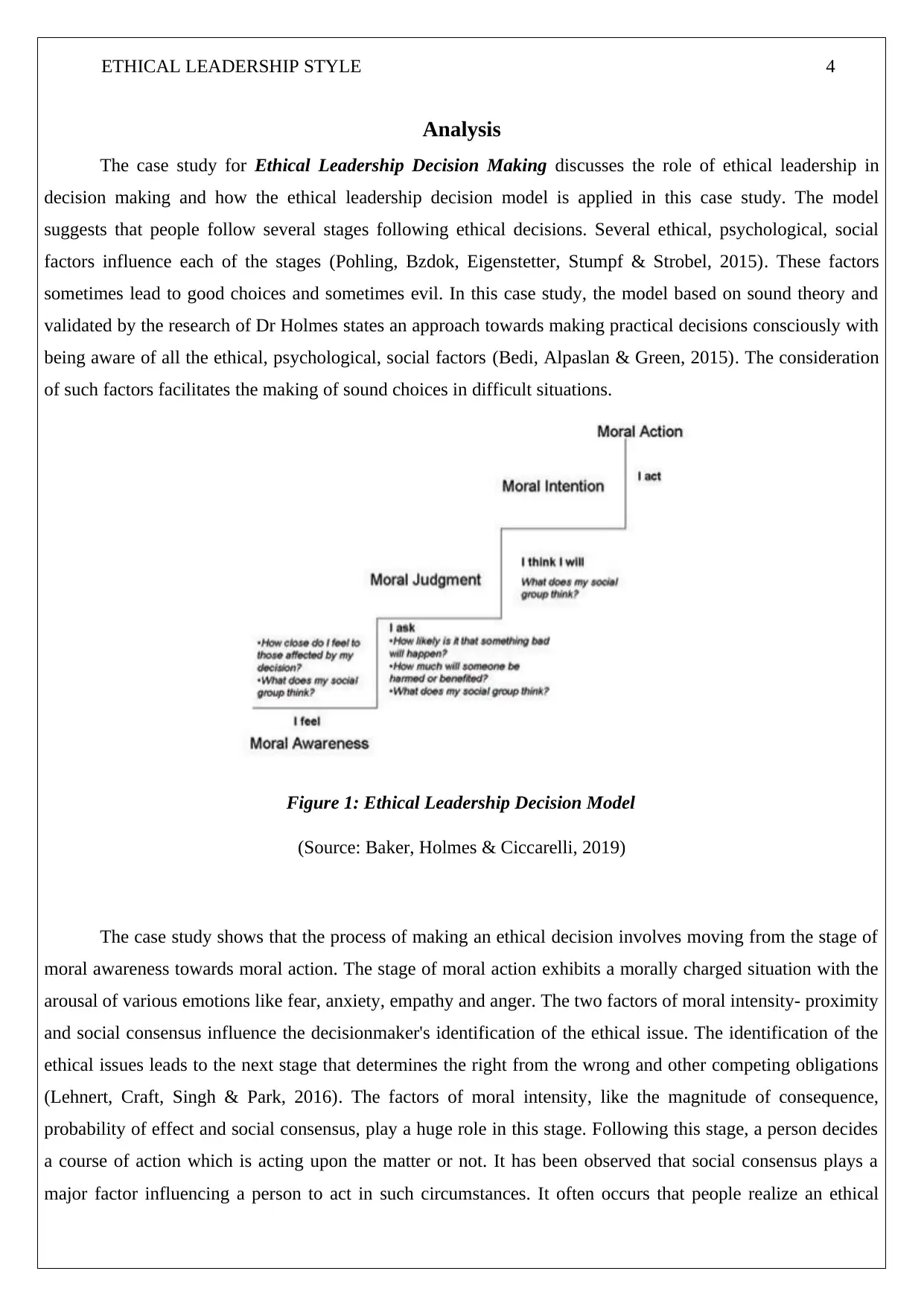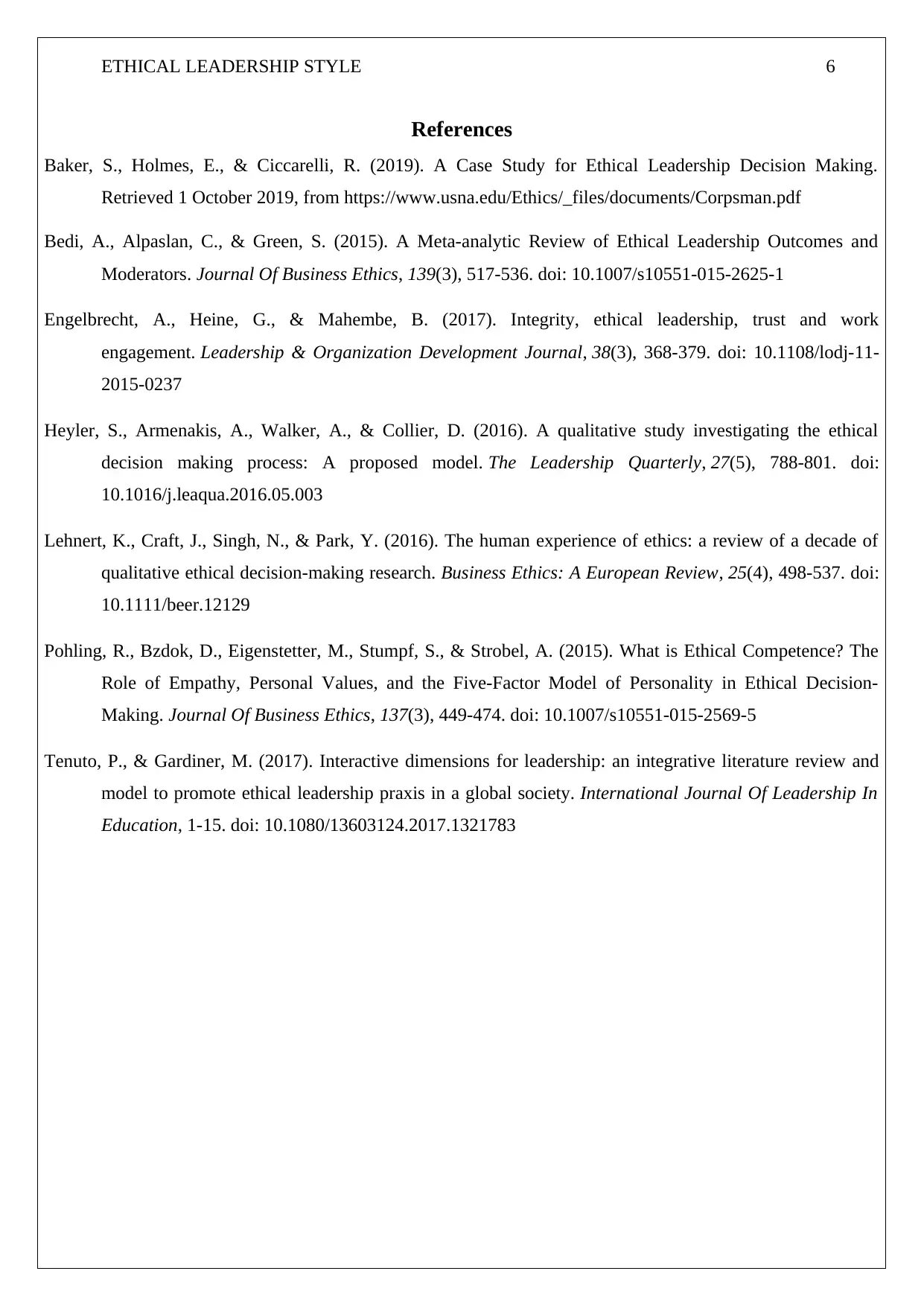Leadership Styles: Ethical Decision Making Reflection and Analysis
VerifiedAdded on 2022/10/11
|6
|1809
|22
Homework Assignment
AI Summary
This assignment delves into the realm of ethical leadership, encompassing both reflection and analysis of ethical dilemmas. The student begins by completing the Ethical Leadership Style Questionnaire, calculating results, and providing a comprehensive assessment of their preferred ethical approach. The analysis component involves a synthesis of the article "A Case Study for Ethical Leadership Decision Making: The Corpsman," comparing the Ethical Leadership Decision Model presented in the article with the information from the textbook. The student's reflection highlights their chosen responses to the questionnaire, justifying their choices based on ethical frameworks like Utilitarian Ethics, Egoism Ethics, Duty Ethics, and Caring Ethics. The analysis section discusses the Ethical Leadership Decision Model, its stages, and the factors influencing ethical decision-making, such as moral intensity and social consensus. The student then references and applies the model to the case study, demonstrating an understanding of how leaders navigate ethical challenges and make decisions that impact their teams and organizations. The assignment emphasizes the importance of moral awareness, judgment, intention, and action in ethical leadership, showcasing how leaders can overcome obstacles and promote ethical behavior.

Running head: ETHICAL LEADERSHIP STYLE 1
ETHICAL LEADERSHIP STYLE
(Leadership Styles and Development)
Name of Student:
Student ID:
Submission date:
Reference style: APA
Word Count: 1250
ETHICAL LEADERSHIP STYLE
(Leadership Styles and Development)
Name of Student:
Student ID:
Submission date:
Reference style: APA
Word Count: 1250
Paraphrase This Document
Need a fresh take? Get an instant paraphrase of this document with our AI Paraphraser

ETHICAL LEADERSHIP STYLE 2
Reflection
In question one, I have selected option B because being a manager, it is my duty to protect my
subordinates by providing them with the correct opinion. The Utilitarian Ethics has scored two points
according to the research. The Utilitarian Ethics states that I need to take a step in such a way that it will benefit
most of the people. In accordance with question two, I have opted for the option E because if I continue to
depend on a performer who has a performance problem, then my job will be at risk. As a manager here, I am
following the Egoism Ethics as it has scored two points in the ranking which is second in the list. In accordance
with the question number three, I have selected option A because I will support the decisions which will be
beneficial for the organization so, I will try to retain the key employee of the project.
The employee is free to move for a better opportunity, but during the project, leaving the key employee
will put the project in danger. In the context of question four, I have selected the option E because I will act
against those employees who will try to commit fraud with me. The employees have given the wrong
information regarding the working hours so that he can enjoy the cash benefit related to that's why I will take
action which will benefit me the most. Egoism ethics has earned two points as per the study. In question five, I
have selected option B because if I increase the quotas then some of my team members will not able to achieve
the target, due to which may lose their jobs also so will check the work quality of those team members who are
fishing the work on or before time in this way most of the people will be benefited in the group. In question six,
I have opted for the option D because I don't want to spoil my relationship with the other senior member of the
management, here I have considered the Caring ethics which has scored two points in the study. In accordance
with question seven, I have opted for option B because in this case, I will do what will be beneficial for most of
the people.
I will ask the management to provide proper orientation to the new employee again so that they can
understand the importance of the job or else I will ask for the replacement to motivate my existing team. I have
considered the Utilitarian Ethics because I am taking an action that will be beneficial for the majority of the
people. In question eight, I have opted for the option A because I would do what is right, as a member of the co-
op has been caught for the first time while shoplifting $30 and the member is also a single parent of four
children I am giving a second chance to the member. This step of mine towards the employees shows duty
ethics. In accordance with question nine, I have opted for option D because I am hiring the candidate to address
the accusation of gender discrimination and improve my reputation in the organization.
As per question ten, I have selected option A because I will do what is right in this situation. The student
has confessed about his mistake and feeling guilty, so I will give him another chance so that he can write a new
report and submit it on time. I have given the maximum answer by considering four ethics, and those are Duty
Ethics, Utilitarian Ethics, Caring Ethics and Egoism Ethics. I have not considered the Justice Ethics and
Virtue Ethics while answering the question asked by the researcher.
Reflection
In question one, I have selected option B because being a manager, it is my duty to protect my
subordinates by providing them with the correct opinion. The Utilitarian Ethics has scored two points
according to the research. The Utilitarian Ethics states that I need to take a step in such a way that it will benefit
most of the people. In accordance with question two, I have opted for the option E because if I continue to
depend on a performer who has a performance problem, then my job will be at risk. As a manager here, I am
following the Egoism Ethics as it has scored two points in the ranking which is second in the list. In accordance
with the question number three, I have selected option A because I will support the decisions which will be
beneficial for the organization so, I will try to retain the key employee of the project.
The employee is free to move for a better opportunity, but during the project, leaving the key employee
will put the project in danger. In the context of question four, I have selected the option E because I will act
against those employees who will try to commit fraud with me. The employees have given the wrong
information regarding the working hours so that he can enjoy the cash benefit related to that's why I will take
action which will benefit me the most. Egoism ethics has earned two points as per the study. In question five, I
have selected option B because if I increase the quotas then some of my team members will not able to achieve
the target, due to which may lose their jobs also so will check the work quality of those team members who are
fishing the work on or before time in this way most of the people will be benefited in the group. In question six,
I have opted for the option D because I don't want to spoil my relationship with the other senior member of the
management, here I have considered the Caring ethics which has scored two points in the study. In accordance
with question seven, I have opted for option B because in this case, I will do what will be beneficial for most of
the people.
I will ask the management to provide proper orientation to the new employee again so that they can
understand the importance of the job or else I will ask for the replacement to motivate my existing team. I have
considered the Utilitarian Ethics because I am taking an action that will be beneficial for the majority of the
people. In question eight, I have opted for the option A because I would do what is right, as a member of the co-
op has been caught for the first time while shoplifting $30 and the member is also a single parent of four
children I am giving a second chance to the member. This step of mine towards the employees shows duty
ethics. In accordance with question nine, I have opted for option D because I am hiring the candidate to address
the accusation of gender discrimination and improve my reputation in the organization.
As per question ten, I have selected option A because I will do what is right in this situation. The student
has confessed about his mistake and feeling guilty, so I will give him another chance so that he can write a new
report and submit it on time. I have given the maximum answer by considering four ethics, and those are Duty
Ethics, Utilitarian Ethics, Caring Ethics and Egoism Ethics. I have not considered the Justice Ethics and
Virtue Ethics while answering the question asked by the researcher.

ETHICAL LEADERSHIP STYLE 3
⊘ This is a preview!⊘
Do you want full access?
Subscribe today to unlock all pages.

Trusted by 1+ million students worldwide

ETHICAL LEADERSHIP STYLE 4
Analysis
The case study for Ethical Leadership Decision Making discusses the role of ethical leadership in
decision making and how the ethical leadership decision model is applied in this case study. The model
suggests that people follow several stages following ethical decisions. Several ethical, psychological, social
factors influence each of the stages (Pohling, Bzdok, Eigenstetter, Stumpf & Strobel, 2015). These factors
sometimes lead to good choices and sometimes evil. In this case study, the model based on sound theory and
validated by the research of Dr Holmes states an approach towards making practical decisions consciously with
being aware of all the ethical, psychological, social factors (Bedi, Alpaslan & Green, 2015). The consideration
of such factors facilitates the making of sound choices in difficult situations.
Figure 1: Ethical Leadership Decision Model
(Source: Baker, Holmes & Ciccarelli, 2019)
The case study shows that the process of making an ethical decision involves moving from the stage of
moral awareness towards moral action. The stage of moral action exhibits a morally charged situation with the
arousal of various emotions like fear, anxiety, empathy and anger. The two factors of moral intensity- proximity
and social consensus influence the decisionmaker's identification of the ethical issue. The identification of the
ethical issues leads to the next stage that determines the right from the wrong and other competing obligations
(Lehnert, Craft, Singh & Park, 2016). The factors of moral intensity, like the magnitude of consequence,
probability of effect and social consensus, play a huge role in this stage. Following this stage, a person decides
a course of action which is acting upon the matter or not. It has been observed that social consensus plays a
major factor influencing a person to act in such circumstances. It often occurs that people realize an ethical
Analysis
The case study for Ethical Leadership Decision Making discusses the role of ethical leadership in
decision making and how the ethical leadership decision model is applied in this case study. The model
suggests that people follow several stages following ethical decisions. Several ethical, psychological, social
factors influence each of the stages (Pohling, Bzdok, Eigenstetter, Stumpf & Strobel, 2015). These factors
sometimes lead to good choices and sometimes evil. In this case study, the model based on sound theory and
validated by the research of Dr Holmes states an approach towards making practical decisions consciously with
being aware of all the ethical, psychological, social factors (Bedi, Alpaslan & Green, 2015). The consideration
of such factors facilitates the making of sound choices in difficult situations.
Figure 1: Ethical Leadership Decision Model
(Source: Baker, Holmes & Ciccarelli, 2019)
The case study shows that the process of making an ethical decision involves moving from the stage of
moral awareness towards moral action. The stage of moral action exhibits a morally charged situation with the
arousal of various emotions like fear, anxiety, empathy and anger. The two factors of moral intensity- proximity
and social consensus influence the decisionmaker's identification of the ethical issue. The identification of the
ethical issues leads to the next stage that determines the right from the wrong and other competing obligations
(Lehnert, Craft, Singh & Park, 2016). The factors of moral intensity, like the magnitude of consequence,
probability of effect and social consensus, play a huge role in this stage. Following this stage, a person decides
a course of action which is acting upon the matter or not. It has been observed that social consensus plays a
major factor influencing a person to act in such circumstances. It often occurs that people realize an ethical
Paraphrase This Document
Need a fresh take? Get an instant paraphrase of this document with our AI Paraphraser

ETHICAL LEADERSHIP STYLE 5
dilemma, decides to do the right thing but does not act. This is often related to the influence of other people that
leads to the failure to take any action.
Another ethical decision-making model in compliance with the case study suggests that the process of
such decision making depends on four grounds. They are moral awareness, moral judgement, moral intention
and moral action. The moral awareness is the step that recognizes the component, moral aspect or dilemma of
any situation (Engelbrecht, Heine & Mahembe, 2017). The moral intention is choosing the moral alternative
that leads to moral action. The step of moral judgement involves the development of opinions that determines
action, motive; the intention is right based on certain parameters.
The moral action or behaviour pertains to the taking of steps with the intent to perform morally right
action. Moral action includes moral efficacy, moral courage and moral ownership. This model states the way
ethical decisions are made by a leader and its influence on others (Baker, Holmes & Ciccarelli, 2019). The
decision-making process emphasizes the role played by moral intensity. It exhibits that when the magnitude of
consequence is great, social consensus and probability of effect is also high, the presence of geographical
proximity and temporal immediacy is there, the ability of the decisionmakers to identify those who will be
affected by the decision and in such cases moral intensity leads to better awareness, judgement, intent and
action of moral (Heyler, Armenakis, Walker & Collier, 2016).
The ethical leadership decision model in the case study is useful in making several ethical decisions. It
can be done by detecting the ethical problem which indicates to the moral awareness section of the model
(Baker, Holmes & Ciccarelli, 2019). The moral judgement helps in weighing various options and shows how
the moral intensity, probability of effect and social consensus lead to decision making the moral intention in the
model help in deciding the course of action according to the following situation (Tenuto & Gardiner, 2017).
The step of moral action answers whether one will follow through the decision according to the intention or
anything would aid or prevent from acting according to the intention.
dilemma, decides to do the right thing but does not act. This is often related to the influence of other people that
leads to the failure to take any action.
Another ethical decision-making model in compliance with the case study suggests that the process of
such decision making depends on four grounds. They are moral awareness, moral judgement, moral intention
and moral action. The moral awareness is the step that recognizes the component, moral aspect or dilemma of
any situation (Engelbrecht, Heine & Mahembe, 2017). The moral intention is choosing the moral alternative
that leads to moral action. The step of moral judgement involves the development of opinions that determines
action, motive; the intention is right based on certain parameters.
The moral action or behaviour pertains to the taking of steps with the intent to perform morally right
action. Moral action includes moral efficacy, moral courage and moral ownership. This model states the way
ethical decisions are made by a leader and its influence on others (Baker, Holmes & Ciccarelli, 2019). The
decision-making process emphasizes the role played by moral intensity. It exhibits that when the magnitude of
consequence is great, social consensus and probability of effect is also high, the presence of geographical
proximity and temporal immediacy is there, the ability of the decisionmakers to identify those who will be
affected by the decision and in such cases moral intensity leads to better awareness, judgement, intent and
action of moral (Heyler, Armenakis, Walker & Collier, 2016).
The ethical leadership decision model in the case study is useful in making several ethical decisions. It
can be done by detecting the ethical problem which indicates to the moral awareness section of the model
(Baker, Holmes & Ciccarelli, 2019). The moral judgement helps in weighing various options and shows how
the moral intensity, probability of effect and social consensus lead to decision making the moral intention in the
model help in deciding the course of action according to the following situation (Tenuto & Gardiner, 2017).
The step of moral action answers whether one will follow through the decision according to the intention or
anything would aid or prevent from acting according to the intention.

ETHICAL LEADERSHIP STYLE 6
References
Baker, S., Holmes, E., & Ciccarelli, R. (2019). A Case Study for Ethical Leadership Decision Making.
Retrieved 1 October 2019, from https://www.usna.edu/Ethics/_files/documents/Corpsman.pdf
Bedi, A., Alpaslan, C., & Green, S. (2015). A Meta-analytic Review of Ethical Leadership Outcomes and
Moderators. Journal Of Business Ethics, 139(3), 517-536. doi: 10.1007/s10551-015-2625-1
Engelbrecht, A., Heine, G., & Mahembe, B. (2017). Integrity, ethical leadership, trust and work
engagement. Leadership & Organization Development Journal, 38(3), 368-379. doi: 10.1108/lodj-11-
2015-0237
Heyler, S., Armenakis, A., Walker, A., & Collier, D. (2016). A qualitative study investigating the ethical
decision making process: A proposed model. The Leadership Quarterly, 27(5), 788-801. doi:
10.1016/j.leaqua.2016.05.003
Lehnert, K., Craft, J., Singh, N., & Park, Y. (2016). The human experience of ethics: a review of a decade of
qualitative ethical decision-making research. Business Ethics: A European Review, 25(4), 498-537. doi:
10.1111/beer.12129
Pohling, R., Bzdok, D., Eigenstetter, M., Stumpf, S., & Strobel, A. (2015). What is Ethical Competence? The
Role of Empathy, Personal Values, and the Five-Factor Model of Personality in Ethical Decision-
Making. Journal Of Business Ethics, 137(3), 449-474. doi: 10.1007/s10551-015-2569-5
Tenuto, P., & Gardiner, M. (2017). Interactive dimensions for leadership: an integrative literature review and
model to promote ethical leadership praxis in a global society. International Journal Of Leadership In
Education, 1-15. doi: 10.1080/13603124.2017.1321783
References
Baker, S., Holmes, E., & Ciccarelli, R. (2019). A Case Study for Ethical Leadership Decision Making.
Retrieved 1 October 2019, from https://www.usna.edu/Ethics/_files/documents/Corpsman.pdf
Bedi, A., Alpaslan, C., & Green, S. (2015). A Meta-analytic Review of Ethical Leadership Outcomes and
Moderators. Journal Of Business Ethics, 139(3), 517-536. doi: 10.1007/s10551-015-2625-1
Engelbrecht, A., Heine, G., & Mahembe, B. (2017). Integrity, ethical leadership, trust and work
engagement. Leadership & Organization Development Journal, 38(3), 368-379. doi: 10.1108/lodj-11-
2015-0237
Heyler, S., Armenakis, A., Walker, A., & Collier, D. (2016). A qualitative study investigating the ethical
decision making process: A proposed model. The Leadership Quarterly, 27(5), 788-801. doi:
10.1016/j.leaqua.2016.05.003
Lehnert, K., Craft, J., Singh, N., & Park, Y. (2016). The human experience of ethics: a review of a decade of
qualitative ethical decision-making research. Business Ethics: A European Review, 25(4), 498-537. doi:
10.1111/beer.12129
Pohling, R., Bzdok, D., Eigenstetter, M., Stumpf, S., & Strobel, A. (2015). What is Ethical Competence? The
Role of Empathy, Personal Values, and the Five-Factor Model of Personality in Ethical Decision-
Making. Journal Of Business Ethics, 137(3), 449-474. doi: 10.1007/s10551-015-2569-5
Tenuto, P., & Gardiner, M. (2017). Interactive dimensions for leadership: an integrative literature review and
model to promote ethical leadership praxis in a global society. International Journal Of Leadership In
Education, 1-15. doi: 10.1080/13603124.2017.1321783
⊘ This is a preview!⊘
Do you want full access?
Subscribe today to unlock all pages.

Trusted by 1+ million students worldwide
1 out of 6
Related Documents
Your All-in-One AI-Powered Toolkit for Academic Success.
+13062052269
info@desklib.com
Available 24*7 on WhatsApp / Email
![[object Object]](/_next/static/media/star-bottom.7253800d.svg)
Unlock your academic potential
Copyright © 2020–2025 A2Z Services. All Rights Reserved. Developed and managed by ZUCOL.





